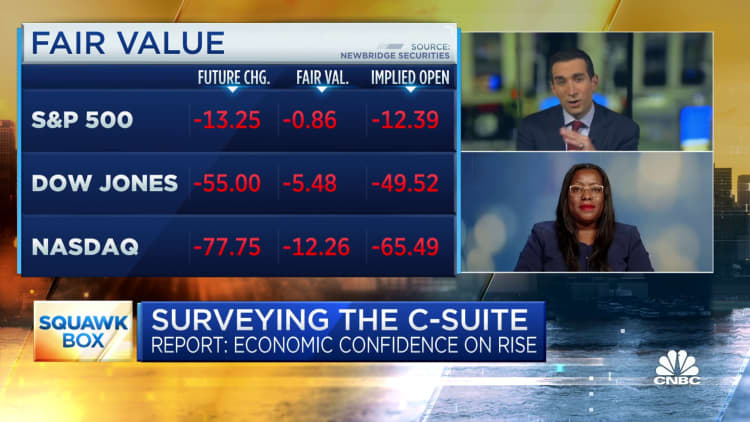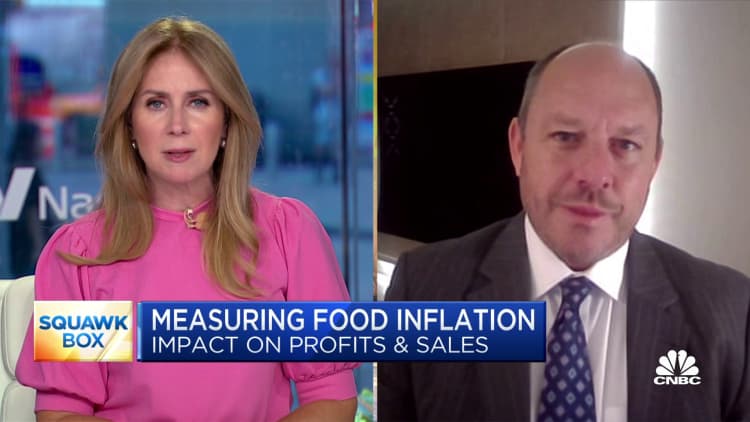A shopper makes their way through a grocery store on July 12, 2023 in Miami, Florida.
Joe Raedle | Getty Images News | Getty Images
As record inflation that only a year ago was over 8% continues to decline, consumers are growing more confident about the economy and their finances. But The Conference Board chief economist Dana Peterson says that businesses should prepare for a different kind of economic headwind on the horizon for later this year and into 2024: a trio of forces that may lead consumers to pull back on spending.
Right now, Peterson says, the data suggests that consumers are spending across the economy and consumer sentiment has taken a turn for the better.
“For the first time in a long time, consumers are saying that their current situations and their expectations for the future are very optimistic,” Peterson told CNBC correspondent Kate Rogers at CNBC’s Small Business Playbook virtual event on Wednesday. “For most of this year, consumers were saying right now is okay, but we’re worried about the future; we think a recession is coming.”
That boost in confidence has come as inflation has waned, workers have continued to see salary increases and the job market has remained steady.
Credit card company data also shows that cardholders continue to spend. “The consumer has remained resilient so far,” Visa CEO Ryan McInerney said during its third quarter earnings call earlier this week, and he added that data “did not indicate any behavior change across consumer segments.”
Real personal spending, which is adjusted for inflation, hit a new high in June, according to the most recent data from the Bureau of Economic Analysis.
But some companies have pointed to signs of consumers cutting back. On PepsiCo‘s third quarter earnings call last month, CEO Ramon Lagurta said that consumers are looking for better deals and shopping more from dollar stores and club retailers. “Every segment of the consumer is making adjustments,” he told analysts on the company’s conference call.
In the latest Conference Board survey of CEOs, which Peterson discussed in a subsequent interview on Thursday morning on “Squawk Box,” a similar bump in confidence was registered, with top executives less pessimistic, but still at a reading below neutral in their economic outlook. “Fewer expect there’s going to be a recession going forward but they still think that something bad is happening around the corner,” Peterson said.

Peterson’s first area of concern outlined at the CNBC small business event relates to the aggressive interest rate hikes made by the Federal Reserve over roughly the past year and a half, 11 rate hikes that have taken its benchmark rate above 5%. The “lagged effects of interest rate hikes will start hitting consumer spending,” Peterson said. As the Federal Reserve has pushed rates higher, Peterson said there’s been a clear impact on the housing market, car buying and other big ticket purchases that consumers would take out a loan for, but cash and credit card purchases at restaurants and stores haven’t slowed. However, “ultimately, that debt service is going to kick in, and it’s going to kick in at a higher rate,” she said.
Secondly, pandemic-era savings that are already being depleted are likely to be exhausted at some point during the upcoming fall, Peterson said. In December, JPMorgan Chase CEO Jamie Dimon said that when the $1.5 trillion in excess stimulus programs finally ran out in 2023, it “may very well derail the economy and cause a mild or hard recession that people worry about.”
Lastly, Peterson said, the restart of student loan payments will cut spending. Loan payments will be due in October, according to the U.S. Department of Education following a three-year pause. It is estimated around 40 million Americans have debt from their education totaling nearly $1.8 trillion, and the typical monthly bill is $350.
“Certainly, for the second half of the year, we’re going to see slower consumer spending,” Peterson said.
However, there is a potential bright side in this scenario, related to the recent decline in inflation.
“Once inflation gets really close to falling, maybe to 3% or even closer to 2%, the Fed will start cutting interest rates,” Peterson said. “We think that’s going to start happening in the second quarter of next year, so that’s a bright scenario for [2024] where you have lower inflation, lower interest rates and a more balanced degree of spending between goods and services.”
The Fed has been more guarded in suggesting any timeline for when inflation returns to its target of 2%. During a news conference last week after its most recent rate hike, Chairman Jerome Powell said inflation has moderated somewhat since the middle of last year, but hitting the Fed’s 2% target “has a long way to go.”

Stay connected with us on social media platform for instant update click here to join our Twitter, & Facebook
We are now on Telegram. Click here to join our channel (@TechiUpdate) and stay updated with the latest Technology headlines.
For all the latest Business News Click Here
For the latest news and updates, follow us on Google News.
